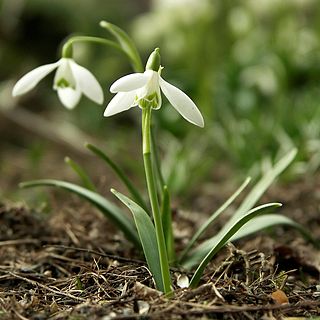
Galanthus, or snowdrop, is a small genus of approximately 20 species of bulbous perennial herbaceous plants in the family Amaryllidaceae. The plants have two linear leaves and a single small white drooping bell-shaped flower with six petal-like (petaloid) tepals in two circles (whorls). The smaller inner petals have green markings.
A galanthophile is an enthusiastic collector and identifier of snowdrop (Galanthus) species and cultivars.

Galanthus nivalis, the snowdrop or common snowdrop, is the best-known and most widespread of the 20 species in its genus, Galanthus. Snowdrops are among the first bulbs to bloom in spring and can form impressive carpets of white in areas where they are native or have been naturalised. They should not be confused with the snowflakes, in the genera Leucojum and Acis.

Acis is a genus of perennial, herbaceous and bulbous plants in the amaryllis family. The genus consists of nine species distributed in Europe and Northern Africa. Acis was previously included in Leucojum; both genera are known as snowflakes.

The Paradisus Londonensis is a book dated 1805–1808, printed by D.N. Shury, and published by William Hooker. It consists of coloured illustrations of 117 plants drawn by William Hooker, with explanatory text by Richard Anthony Salisbury.

Leucojum aestivum, commonly called summer snowflake or Loddon lily, is a plant species widely cultivated as an ornamental. It is native to most of Europe from Spain and Ireland to Ukraine, with the exception of Scandinavia, Russia, Belarus and the Baltic countries. It is also considered native to Turkey, Iran and the Caucasus. It is naturalized in Denmark, South Australia, New South Wales, Nova Scotia and much of the eastern United States.
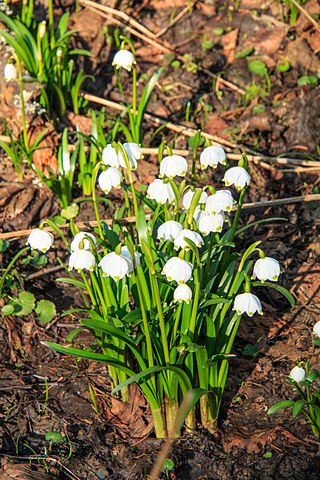
Leucojum vernum, called the spring snowflake, is a species of flowering plant in the family Amaryllidaceae. It is native to central and southern Europe from Belgium to Ukraine. It is considered naturalized in north-western Europe, including Great Britain and parts of Scandinavia, and in the US states of Georgia and Florida. This spring flowering bulbous herbaceous perennial is cultivated as an ornamental for a sunny position. The plant multiplies in favourable conditions to form clumps. Each plant bears a single white flower with greenish marks near the tip of the tepal, on a stem about 10–20 cm (3.9–7.9 in) tall, occasionally more.
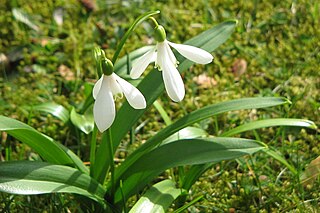
Galanthus woronowii, the green snowdrop or Woronow's snowdrop, is a bulbous plant native to north-east Turkey and the west and central Caucasus. In cultivation particularly, it has often been confused with two other species with broad green leaves and a single green mark on the inner tepals: Galanthus ikariae and Galanthus platyphyllus.

Galantheae is a tribe of plants belonging to the subfamily Amaryllidoideae of the Amaryllis family (Amaryllidaceae). As of 2017, it contains three genera, although more were included previously. The position of the ovary is inferior.

Galanthus elwesii, Elwes's snowdrop or greater snowdrop, is a species of flowering plant in the family Amaryllidaceae, native to the Caucasus.

Acis autumnalis, the autumn snowflake, is a species of flowering plant in the family Amaryllidaceae. A short bulbous perennial, it is found on the western shores of the Mediterranean, from Portugal, Spain and Morocco to Sicily and Tunisia.
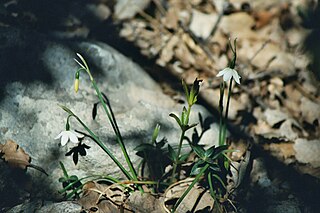
Acis fabrei is a bulbous flowering plant in the family Amaryllidaceae, native to France. It has white flowers that appear in late spring after the leaves. Although first collected in 1882, it was not scientifically described until 1990. It is now known from only four populations in the Vaucluse department in south-east France, around Mont Ventoux and the River Nesque. It is considered to be a "threatened species".

Acis ionica is a species of flowering plant in the family Amaryllidaceae, native from south-western Albania to western Greece. It was initially confused with what is now Acis valentina, a species found in Spain near Valencia.
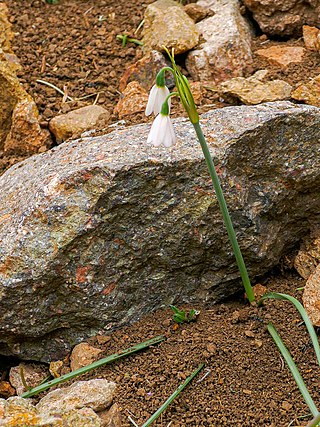
Acis longifolia is a species of flowering plant in the family Amaryllidaceae, endemic to Corsica. Its white flowers appear in spring. It is sometimes cultivated as an ornamental plant, but is not fully frost-hardy.
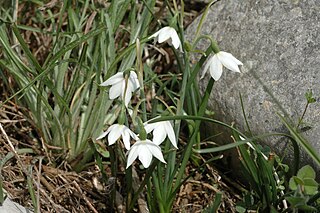
Acis nicaeensis, sometimes called the French snowflake, is a species of flowering plant in the family Amaryllidaceae, native to south-eastern France. A small spring flowering bulb with white flowers, it is cultivated as an ornamental plant.

Acis tingitana is a species of flowering plant in the family Amaryllidaceae, native to north Morocco. Rare in cultivation, it is not fully frost-hardy.

Acis trichophylla is a species of flowering plant in the family Amaryllidaceae, native to Portugal, Spain and Morocco. It has very narrow leaves. The flowers are produced in late winter or early spring and are usually white, but sometimes pink-tinged or all pink. The species is cultivated as an ornamental bulb, but requires protection from hard frost.
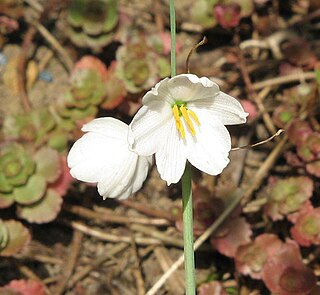
Acis valentina is a species of bulbous flowering plant in the family Amaryllidaceae, native to eastern Spain. Its white flowers appear in autumn. It can be grown as an ornamental bulb, but may need protection from hard frost.
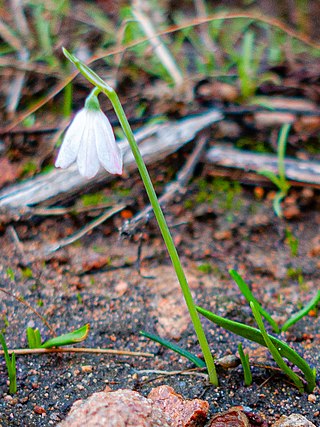
Acis rosea, known as the rose snowflake, is a species of flowering plant in the family Amaryllidaceae, native to Corsica and Sardinia. Unlike most members of the genus Acis, it has pink rather than white flowers. It is grown as an ornamental plant but requires protection from frost.

Galanthus reginae-olgae, Queen Olga's snowdrop, is a species of flowering plant in the family Amaryllidaceae, native to Sicily and the west and north-west Balkans. Some variants produce their pendant white flowers in autumn, others in winter and early spring. It is cultivated as ornamental bulbous plant, preferring warmer situations in the garden than other species of Galanthus (snowdrops).






















